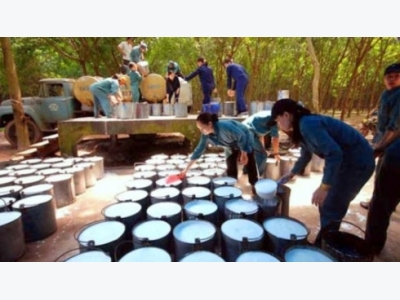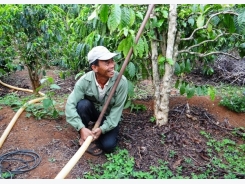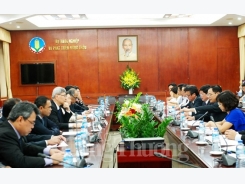Rubber exports to EU encounter difficulties

Vietnam’s rubber exports to the European Union market are set to encounter difficulties as the EU adds natural rubber to the Critical Raw Material List.
Rubber export prices increase
Vietnam exported 174,000 tons of rubber in September, earning US$279 million, an increase of 1.7% in volume and 6.4% in value, according to the Ministry of Agriculture and Rural Development (MARD).
The average export price surged 4.6% to over US$1,603 per ton over the previous month.
The first nine months of the year saw the country grossing US$1.66 billion from exporting 979,000 tons of rubber. This is up a considerable 13.3% in volume and an impressive 52.7% in value. The average export price increased 34.7% to US$1,695 per ton against the same period last year.
The domestic market also saw a rise in the price of rubber latex with an average price of VND 12,500 per kilo in the southern province of Dong Nai.
The production of natural rubber is falling further behind demand; as a result rubber export prices are predicted to increase even further in 2017.
According to August’s report by the Association of Natural Rubber Producing Countries, there is forecast to be a 500,000 ton deficit of natural rubber in the first eight months of the year. Meanwhile, the rubber output reached only 8,038 million of tons, far short of the 8,544 million tons consumed in the same period.
Other factors such as fluctuations in the oil industry in regional markets, the relative strength of currencies and geopolitical tensions will impact on the increase in the rubber price in the time ahead.
In the first eight months of the year, Vietnam’s rubber was mainly exported to China, with 509,500 tons valued at US$867 million and accounting for 69%. These figures represent an increase of 25.82% in volume and 73.05% in value.
Other key markets for Vietnam’s rubber exports are Malaysia (making up 7%) and the Republic of Korea (4%) in addition to other markets as the US, the Netherlands, and Sweden.
Notably, rubber exports to the Singaporean market marked an impressive growth, quadrupling in quantity and over 5.2 times in value. The average export price surged 18.8% to more than US$1,503.
Rubber exports to EU face difficulties
Although Vietnam earned US$111 million from exporting 62,400 tons to the EU in the eight months of the year, it is said to encounter difficulties when exporting to the demanding market in the future.
The EU officially announced that it has added natural rubber to the Critical Raw Material List, underlining the need for a secure, sustainable and affordable supply for the EU manufacturing industry in the future.
Natural rubber is the only biotic raw material to be included in the 27 strong list. The list is comprised of raw materials that are proposed to the EU for assessment and approval, according to the European Tyre & Rubber Manufacturers’ Association (ETRMA).
Fazilet Cinaralp, General Secretary of the ETRMA, said that natural rubber would receive proper political attention and consequent support when dealing with issues related to the supply of natural rubber.
The introduction of natural rubber to the List will help enhance the competitive edge of the rubber industry and promote the production of natural rubber. It will also increase awareness of the potential risks of raw material supply and support the European Commission in negotiating trade agreements.
The list will into force effect within three years, as of September 13, and serve a platform for the implementation of the 2030 Agenda on Sustainable Development and its Sustainable Development goals.
Therefore,Vietnamese rubber exports to the global market are up against rival producers such as Thailand (the world’s largest producer and exporter of natural rubber), Indonesia and India.
The EU considers Vietnam as the world’s fourth largest producer of natural rubber, making up 8% of total supplies.
Moreover, the EU also emphasized that Indonesia is the largest source of natural rubber for European users, accounting for 32% of total supplies in the EU market, trailed by Malaysia (20%), the Ivory Coast (12%) and Thailand (7%).
For Vietnam to gain a greater standing in the global rubber market and enhance the competitive edge of Vietnamese rubber, local rubber production companies will need to adjust to the new guidelines for supply chains, ensuring that input materials to meet the strict requirements in terms of the rule of origin.
If they are successful in this, they will be able to take full advantage of the preferential tariffs afforded to them when the Europe-Vietnam Free Trade Agreement comes into effect.
Economic experts also advised local businesses to learn about the requirements and characteristics of each prospective market to ensure efficient exports and to avoid investigations into the origin and application of trade defence measures.
Related news
Tools

Phối trộn thức ăn chăn nuôi

Pha dung dịch thủy canh

Định mức cho tôm ăn

Phối trộn phân bón NPK

Xác định tỷ lệ tôm sống

Chuyển đổi đơn vị phân bón

Xác định công suất sục khí

Chuyển đổi đơn vị tôm

Tính diện tích nhà kính

Tính thể tích ao



 Can Tho to ship first rice batch to…
Can Tho to ship first rice batch to…  Vietnam, Malaysia discuss ways to increase farm produce…
Vietnam, Malaysia discuss ways to increase farm produce…